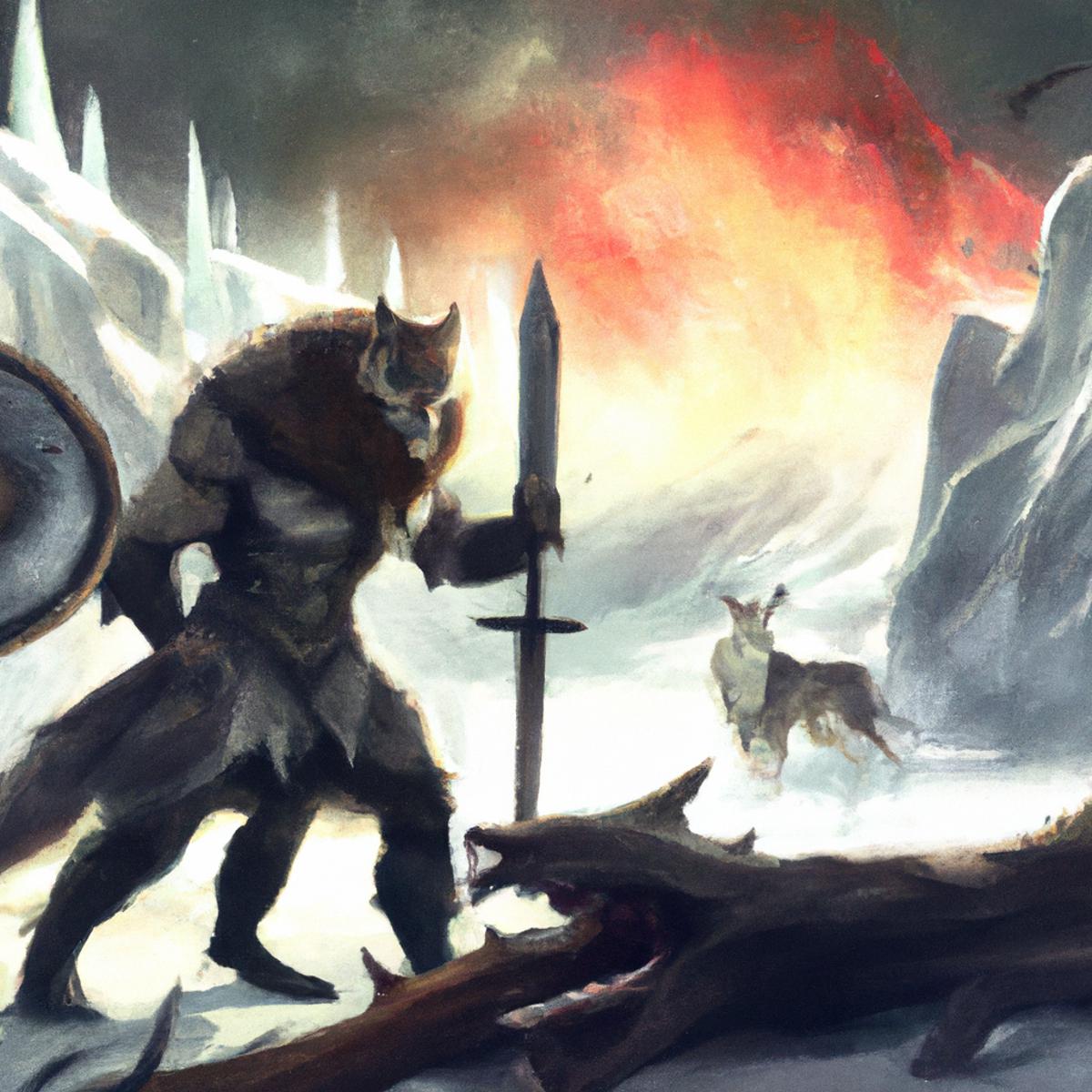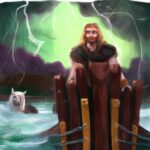
Fenrir, also known as Fenrisúlfr, is a mythological figure from Norse mythology. He is a giant and fearsome wolf, son of the god Loki and the giantess Angrboda. According to legend, Fenrir was raised by the Asgardian gods in the palace of Asgard. As he grew older, he became bigger and stronger, which caused great concern among the gods. Finally they decided to bind him with a chain called Gleipnir made from the hair of a virgin, the whiskers of a cat and other magical elements. This chain was so strong that Fenrir couldn't break it even with his incredible strength.
According to Norse legend, Fenrir will be released at the end of Ragnarok (the end of the world) to fight Odin and destroy the world. The final result will be the definitive triumph over the Asgardian gods by Fenrir and his descendants. However, after this epic battle there will be a rebirth in which all the dead will come back to life to start a new improved world without wars or hatred between the divine and human races.
In many ancient cultures, Fenrir was considered a symbol of power and destruction, but also as a representative of the natural balance between opposing forces; his release symbolized the inevitable but necessary end to make way for something better on earth.
Summary
Fenrir the wolf is an important figure in Norse mythology. He is a gigantic gray wolf who was raised by the Aesir gods. According to legend, Fenrir was raised by the gods to be their guardian, but he soon became so large and powerful that they feared he would become uncontrollable. The gods tried to bind him with magical chains, but he easily broke them. Finally, the god Odin confronted him and trapped him using a chain made from the saliva of the sea monsters Gullinbursti and Leyding.
In Norse mythology, Fenrir is considered to be a symbol of chaos and destruction. It is said that when he is released at the end of time (Ragnarok), he will lead the armies of evil against the Aesir gods in an epic battle. This battle will result in the end of the world as we know it today.
Fenrir has also been represented through various art forms over the centuries, from sculpture to painting and even modern literature like books and movies. This figure has been revered by many ancient cultures due to its strong and profound symbolism about human chaos and destiny.
Main characters
Fenrir the wolf is a character from Norse mythology, and is also known as Fenrisúlfr. He is a monstrous creature, son of the god Loki and the giantess Angrboda. Fenrir was raised by the Aesir gods, but his growth was so rapid that he soon became too large and dangerous for them. The gods decided to bind him with a chain called Gleipnir, made of roots, women's hair, and fish saliva.
Fenrir was destined to be the destroyer of the world during Ragnarok, the final battle between the Aesir gods and the Jotunheim giants. It is said that his size was so large that he could swallow the sun and the moon in one bite. The wolf broke free during Ragnarok and attempted to destroy the entire world before being defeated by Odin in epic combat.
Despite his reputation as a destroyer of the world, Fenrir also represents the powerful wild spirit that exists within all of us; it is the symbolism of the primordial drive to survive at any cost. He is associated with indomitable physical strength and uncontrolled primal instincts; he is the archetype of the relentless and invincible warrior in the final battle against the dark forces that threaten our existence.
intervening gods
Fenrir the wolf is one of the most feared creatures in Norse mythology. He is a legendary figure appearing in Germanic and Scandinavian mythology, and is said to be the son of the god Loki and the giantess Angrboda. Fenrir is a giant wolf with superhuman strength, capable of destroying mountains with his claws and teeth.
In ancient Norse myths, Fenrir is said to have been raised by the Aesir gods as a domestic animal, but his size grew so fast that the gods feared for his destructive power. The gods tried to bind Fenrir with magical chains to prevent him from causing harm to humanity, but the wolf was too strong to be contained by them. Ultimately, the gods decided to sacrifice the Norse warrior Tyr to calm Fenrir down and keep him in check.
Fenrir is also associated with Ragnarök (the end of the world), as it is said that he will be the one to kill the god Odin during this cataclysmic event. After Ragnarök, it is believed that Fenrir will be freed from his chains and will lead all the monsters in one last attack against Asgard (the home of the Aesir).
In modern culture, Fenrir remains a powerful and intimidating symbol for many people. It represents uncontrollable and unpredictable chaos; that against which there is no defense possible and no victory easily won. This image has been used in numerous modern literary works as a representation of dark and invincible evil; however, it has also been used as a positive symbol in several modern epic stories as a representation of the courage necessary to overcome the greatest adversities.
Main topics covered
Fenrir the wolf is one of the most important figures in Norse mythology. He is known as the son of the god Loki and the giantess Angrboda, and it is said that he was raised by the Aesir gods. Fenrir is a huge wolf, so large in size that the gods feared his power. For this reason, they decided to chain him with magical chains made by the gods themselves.
Fenrir is considered a symbol of destruction and chaos in Norse mythology, since it is believed that he will be responsible for Ragnarok, the end of the world as the Norse know it. However, he is also seen as a symbol of freedom and independence due to his resistance to being shackled by the Aesir gods.
In modern popular culture, Fenrir has been used in many literary works and movies to represent rampant evil or chaos. He has also appeared in video games and video games where he is usually portrayed as a huge villain or monstrous final boss to defeat.
In addition to his presence in modern culture, Fenrir also features heavily in traditional Norse art and has even been used as a symbol to represent various Viking tribes during the Middle Ages. It is present in many ancient literary works written by Icelandic and Norwegian poets during this historical period.
In short, Fenrir the wolf is a key character in Norse mythology associated with destruction and chaos pursued by the Aesir gods themselves due to his enormous size and enormous strength; However, he also symbolizes freedom and independence by resisting being chained by themselves, being remembered to this day thanks to his presence within traditional Nordic art as well as many modern popular culture.



